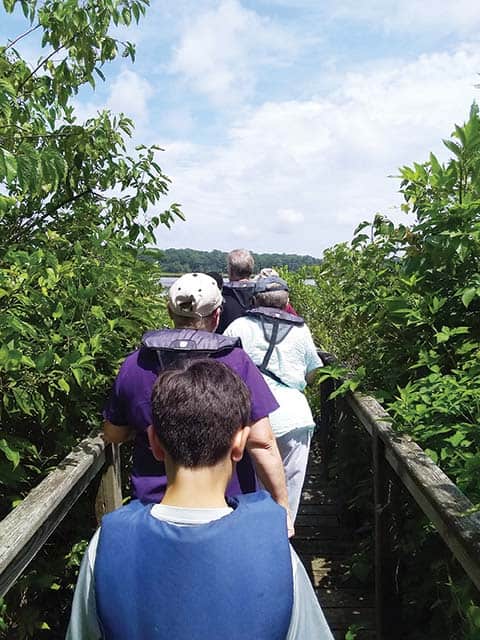Diversions & Excursions: Patuxent River Park
Longing for a vacation but don’t have the time or budget to go far and stay long? A stay-cation fits the bill.
Within a day’s drive of Annapolis you can find leisure, recreation and delights that fill your summer fun list and don’t require airfare, time off work or hotel stays.
On a hot and muggy Sunday in July, a boat ride is a sure way to catch a rare cool breeze. At the Patuxent River Park pontoon boat Capt. Matt Felperin motored a party including my two sons and me up the river to look at wildlife and talk about the historical and cultural significance of the river.
From its source 115 miles to the Bay, the Patuxent River is the largest and longest river entirely within Maryland. Its watershed is the largest completely within the state.
In the 1600s, when colonists arrived along the river, they set about cutting down the forest to establish tobacco fields. Large ships servicing those tobacco plantations used the river as a major thoroughfare.
But heavy sediment from the cleared land entered the river and filled in the waterway, burying aquatic vegetation. The former port of Charles Town was relocated to what is now the site of the Mount Calvert Historical and Archaeological Park.
Humans would eventually change the river’s depth, width and usage. Today recreation is the primary attraction.
There is plenty to do and see along the river.
Plant and animal life are abundant.
“Several different species of aquatic plants dominate the landscape,” Felperin told us. We saw invasive phragmites, in addition to cattails, water lily, arrow arum and the abundant wild rice.
Maryland’s largest wild rice marsh is at Patuxent River Park. “It’s a big deal,” Felperin said. “The warm-season grass produces hundreds of seeds per plant. Seeds drop in September, coinciding with the fall migration. It’s a haven for lots of migratory birds. Marshes like this are nature’s gas station. The birds can’t make the entire trip in one day, so they do it in stages.”
The sora rail depends on the marsh. “It’s a little bird that kind of looks like a chicken,” he said. “It has long toes to keep from sinking in the mud.”
Soras rely on the wild rice to refuel during their journeys from breeding grounds up north to their winter homes in the south. These strong fliers fatten up along the Patuxent River before flying on to the marshes of Florida, the Caribbean and even South America.
Wild rice suffered from an influx of Canada geese that were eating the leaves of the plant, thus stunting their growth. “This plant adapted to birds eating the seeds but didn’t have a defense against geese. They were eventually fenced out,” Felperin said. “They need a lot of space to take off, so fencing the edge of the vegetation prevents them from swimming in and feeding on the rice.”

Kids — and adults — who enjoy spotting wildlife can easily see a dozen creatures in a one-hour boat ride. We counted many osprey families, which can also be seen on the park’s online web camera, as well as turtles, red-bellied cooters, great blue herons, kingfishers, butterflies, dragonflies and tiny fish that leaped out of the water as the boat motored by.
The park offers kayak and canoe rentals (8:30am-3:30pm) at a reasonable rate; or you can bring your own. There are tent campsites, a picnic pavilion, a very cool “natural” playground, two boat launches, fishing piers, hiking trails and environmental education events.
The on-site Patuxent Rural Life Museums are a collection of buildings dedicated to the heritage of the region, including a tool museum, a blacksmith shop, the tobacco farm museum, a log cabin with a privy, chicken coop and meat house, a 1923 Sears catalog house and a hunting, fishing and trapping museum. The museums are open weekends (1-4pm), April thru October.

The Critical Area Tour, a roadway connecting Jug Bay Natural Area with Merkle Wildlife Sanctuary, is open daily for hiking and bicycling and open Sundays for vehicles (10am-3pm).
Guests are encouraged to call and request programs, even ones not on the calendar. All it takes is a minimum number of participants to set up a class; Felperin, for example, teaches nature photography. A small fee is charged.
A few water-trail campsites are accessible only by boat. Paddling enthusiasts could easily spend a day on the river, then enjoy a night under the stars at a quiet and uncrowded campsite with only the resident otters to bother you.
The Patuxent River faces the same challenges as the entire Bay. But in its mid-reaches along Patuxent River Park, riparian buffers support the river’s health. “You look up and down here and there are few residences,” Felperin said. “It’s almost all forest, marsh and wetlands here.”
After an afternoon on the river, our family made plans to come back again soon to explore more of the park. Humans may have changed the river over the centuries, but that river can change us, too. In order for that to happen, we must continue to find value in these vital natural resources and share them with our children.
